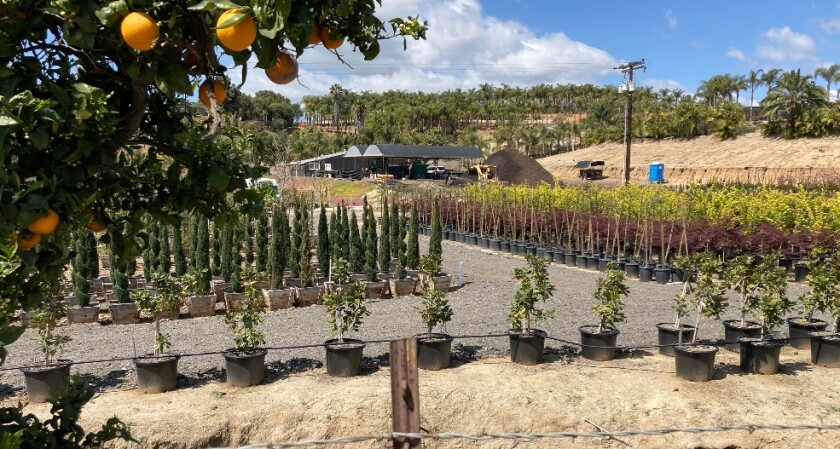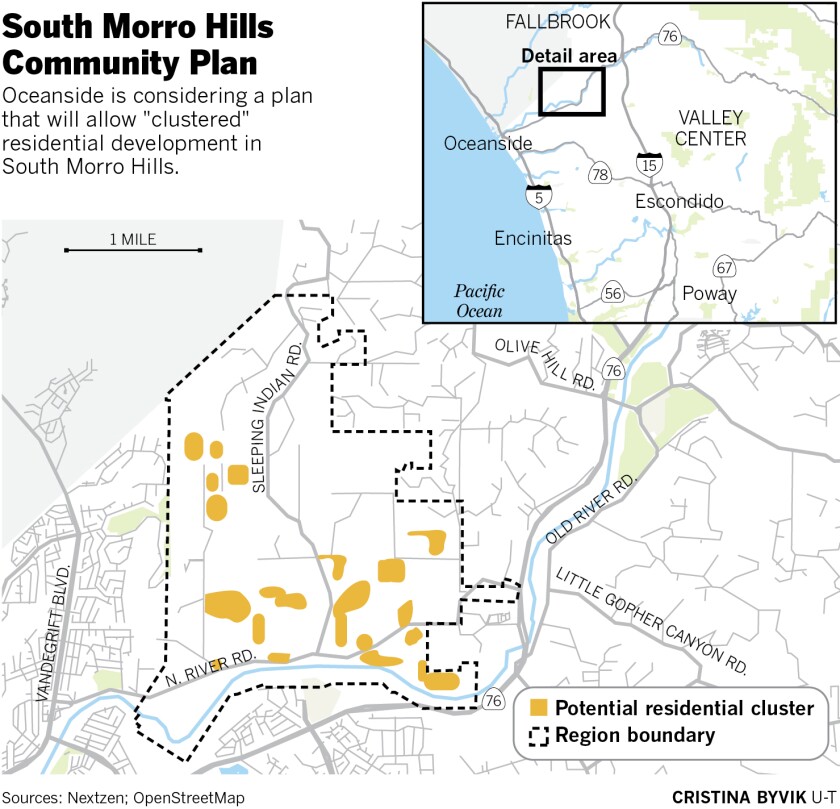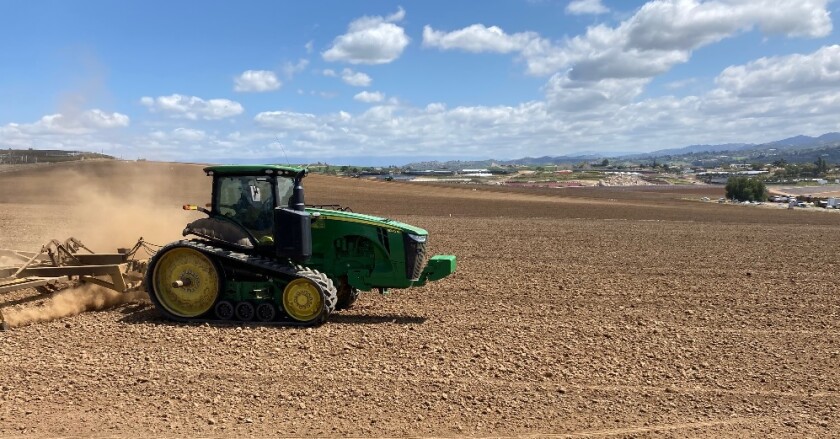A proposed community plan for South Morro Hills would allow thousands of new homes in Oceanside’s last agricultural region.
The present zoning of 2.5-acre minimum lots would be reduced to a 1-acre minimum, and homes would be “clustered” on portions of parcels 20 acres or larger under the draft South Morro Hills Community Plan.
“This ... is intended to preserve agriculture,” said Jeff Hunt, Oceanside’s city planner, in a presentation last week to the Oceanside Planning Commission. “It speaks to making farms more profitable so that they don’t subdivide ... We should be rewarding true farmers with additional income, and not just the hobby farmers or the 2.5-acre estate lots.”
South Morro Hills includes about 3,500 acres or 5.5 square miles in the northeast corner of Oceanside near Camp Pendleton and Fallbrook. The area has a rich history of farming avocados, tomatoes, strawberries, cut flowers, succulents and wholesale nursery plants and trees.

A nursery in Oceanside’s South Morro Hills near the intersection o f Sleeping Indian Road and North River Road.
(Phil Diehl)
The proposed site of North River Farms, which would have allowed up to 585 homes on more than 200 acres in a southwest corner of Morro Hills, is not included in the community plan. Voters overturned the City Council’s approval of the development by a 67 percent to 33 percent margin in the November general election.
On Nov. 6, 2019, at the same meeting where the City Council approved the controversial North River Farms project, the council also instructed staffers to work with consultants and residents to create the South Morro Hills Community Plan.
“In recent years, there have been increased challenges to farming in South Morro Hills,” said Rob Dmohowski, the city’s senior planner, in his presentation to the Planning Commission.
Rising costs for water and labor, and increased pressure for residential development have made farming more difficult. In recent years, the city has encouraged agritourism as a way to supplement farmers’ income.
Agritourism alone is not the answer, however. It’s not enough to pay for infrastructure such as roads, public safety, and water and sewer connections. Most of Morro Hills has no public sewers and relies on septic systems.
The proposed community plan would be used along with an updated city master plan to guide the future development of the region.

Farmland conservation is guiding principal No. 1 for the South Morro Hills Community Plan, Dmohowski said.
One way to accomplish that would be to allow “clustered” residential development at one dwelling per acre only on parcels of 20 acres or larger, he said. Also, only 25 percent or less of each parcel could be developed with homes.
However, the 20 dwellings allowed on a 20-acre parcel could all be built in the 5 acres designated for development, resulting in a density higher than one unit per acre for the buildable land.
Reducing the minimum lot size from 2.5 acres to 1 acre is estimated to allow an additional 2,029 dwellings in the region after excluding steep terrain and undevelopable areas, according to a city staff report. Also, many of the houses would be allowed to have “accessory dwelling units,” also known as “granny flats,” that would increase the overall number of homes.
Planning commissioners had questions about many aspects of the draft plan.
“The first part of the document, it really reads like a developer’s handbook,” Commissioner Curtis Busk said of the plan, though farther along there’s more about conservation.
Cluster development needs a better explanation in the plan, Busk said. It’s unclear whether the 25 percent of a parcel that could be developed must be in a single contiguous piece or in multiple pieces throughout the property.

A tractor prepares a field for a spring crop Friday along Wilshire Road in South Morro Hills.
(Phil Diehl)
Also unclear in the plan is a provision that allows some owners to sell their residential development rights to the owners of larger parcels. That provision could increase the overall percentage of South Morro Hills that would be changed from farming to homes.
Residential development does not provide enough tax revenue to pay for all the services that homes require, said Busk and others. Only commercial development and farming create a positive flow of revenue, so thousands of new homes without new jobs or businesses would be a drain on the city’s general fund.
About 10 people spoke during the public comments session of the commission meeting. Most of the speakers have addressed the issue at previous public meetings to discuss North River Farms and South Morro Hills.
The community plan “ignores the overwhelming plea of residents to preserve farming,” said Dennis Martinek, a South Morro Hills resident and former Oceanside Planning Commission member.
It maximizes conflicts between housing and agriculture, Martinek said.
It forces Oceanside taxpayers to subsidize development by paying for water and sewer lines and other improvements in the region, he said, and it contributes to sprawl development.
“We all know that housing does not belong in farmland,” said another speaker, resident Cindy Davenport. “People complain about the noise and odors.”
However, members of the region’s largest and oldest farming families defended the plan.
“Commercial farming is becoming more and more difficult and almost impossible,” said Michelle Castellano Keeler, an employee of Melano and Company, a third-generation farming family and one of the region’s biggest producers of cut flowers. “You can preserve land, but if farmers can’t farm it, it isn’t farmland any more.”
Melano and the region’s other large farmers want the option of building homes on their land when agriculture is no longer profitable. They often say that without reducing the minimum lot sizes, the region will eventually become a checkerboard of gated mansions on estate-sized lots.
Neil Nagata, also a third-generation Oceanside farmer, said he supports the community plan, but it should be more flexible.
“The plan must take into consideration economic realities,” Nagata said. “This plan will assist farmers to adapt and develop multiple alternatives ... this is in the best interest of the city.”
Commissioner Robyn Goodkind said that some of the concepts in the plan were confusing, such as how the residential clusters would work and what the sizes would be, but, “We’re on the right path.”
Commission Chair Tom Rosales called it “a great starting point” and said some good issues had been raised.
A presentation to the Oceanside City Council is scheduled for April 28. After that, the plan will be revised and brought back to the Planning Commission at a date yet to be determined.
"last" - Google News
March 28, 2021 at 08:00PM
https://ift.tt/3ueLgA3
Plan would increase homes in Oceanside's last agricultural region - The San Diego Union-Tribune
"last" - Google News
https://ift.tt/2rbmsh7
https://ift.tt/2Wq6qvt
Bagikan Berita Ini















0 Response to "Plan would increase homes in Oceanside's last agricultural region - The San Diego Union-Tribune"
Post a Comment